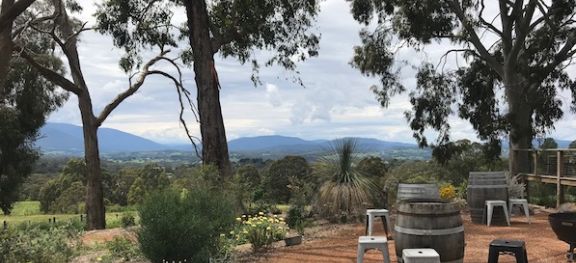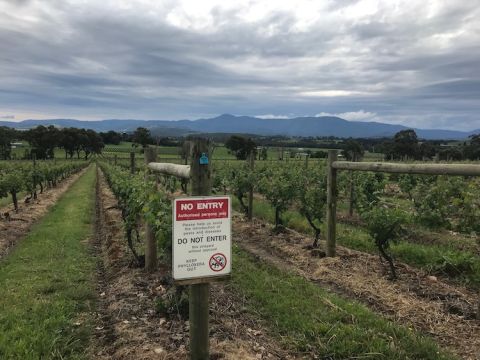Chinese adventures in Australian wine

3 December 2020 What a difference a year makes. We're republishing this article in the light of China's recent announcement of import tariffs of between 107 and 212% on the wines of Australia, for which until very recently China was by far the most important customer. Sino-Australian relations have sunk to an all-time low since Canberra asked for an independent inquiry into the origins of COVID-19.
16 November 2019 Direct Asian involvement in Australian wine production has been growing rapidly. A version of this article is published by the Financial Times. See also All change in the Yarra.
Helen & Joey Estate winery in the Yarra Valley outside Melbourne could hardly sound more Australian, but in fact Helen and Joey are the adopted English names of a Chinese couple who are just two of the hundreds of mainland Chinese-born business people who have decided to invest in Australia’s wine regions.
I spent a week in Australia recently and, as in Bordeaux where dozens of minor châteaux were acquired by Chinese investors in recent years, there is some suspicion of these Asian incomers. For some of them it seems that acquisition is enough. It gives them the right to use a name, possibly an image, for marketing purposes back home in China, and tales of staff and even vines and wines left in limbo are legion. Some properties, certainly in Bordeaux, seem to have been bought with money laundering rather than wine production in mind.
But there are other examples of much more positive Chinese input. China is by far the most important market for Australian wine today, worth more than twice as much as the second most valuable market, the US. (We Brits still import a huge volume of Australian wine but it tends to be the cheap stuff.)
Treasury Wine Estates, one of the two companies that dominate the Australian wine scene, owed 41% of their earnings last year to sales in Asia, chiefly China, a country that hardly figured in Australian wine export statistics a decade ago. Treasury cunningly target their annual release of The Penfolds Collection (sic) at particularly well-heeled Chinese collectors, with a new must-have wine emerging every year. One year it was wine in a special ampoule. This year it was a new Shiraz blend, Bin 111a, optimistically priced at £850 a bottle in the UK, about 60% more than their world-famous flagship Penfolds Grange with its six decades of history.
So mightily have Chinese sales swollen Treasury coffers that TWE is on the trail of acquisition themselves, in some of Europe’s most hallowed wine regions. Penfolds have just launched a range of champagnes, co-branded with champagne producer Thiénot, and are aiming to buy some of the world’s most expensive vineyard land, in Champagne. Earlier this year Treasury bought a Bordeaux château, Cambon La Pelouse, a solid cru bourgeois. But a TWE director assured me during my recent visit to Australia that what they are really after is several notches above cru bourgeois in Bordeaux’s strict ranking, a classed growth property.
Chinese interest in the Australian wine scene is hardly surprising, but what is surprising is how fast and materially it has grown, as I learnt when I got together with a group of Yarra Valley winemakers recently. Contract winemaking is an important feature of Australian wine and Rob Dolan makes wine for 15 different wine companies in the Yarra. Five of them are Chinese-owned and four of these produce wine exclusively for export to China.
Steve Webber, regarded as a father figure by the Yarra Valley wine community, told me that about 15% of Yarra vineyards is currently Chinese-owned, ‘until they realise how difficult it is to make money from them,’ he added wryly. (The last time I had visited him at his De Bortoli winery was exactly 10 years ago, the day after Black Saturday when bushfires fatally ravaged the valley. He is just one of many wine producers to have undertaken a long haul back to profitability after that tragedy.)
Current Australian visa laws welcome prosperous Chinese incomers and a familiar pattern is that Chinese families have children at school or college in Melbourne, visit the Yarra Valley, a particularly pretty wine region less than an hour from the city, and decide to invest there. ‘But many of them are preyed on by consultants and builders,’ according to Dolan, the new owners sometimes just ‘sitting on the wine they make’. Tim Shand of Punt Road winery agreed there is often a lack of strategy among these Chinese newcomers to wine.
But I did not detect outright prejudice against the Chinese wannabe vignerons. Some of them, such as Helen of Helen & Joey, are thoroughly approved of. She was part of the committee that organised the recent Yarra Valley Chardonnay Symposium that was surprisingly successful considering it was held on the hottest October day for 80 years in premises without air conditioning. Helen has cleverly hired popular Master of Wine Meg Brodtmann to make Helen & Joey wine[opt cut:, which is currently being poured in the Etihad lounge at Melbourne airport].
Sunshine Creek and Handpicked Wines were also mentioned as Chinese-owned Yarra wine enterprises very obviously in it for the long haul, and there is widespread admiration for Yiping Wang who made his fortune retailing wine in China and in 2017 bought the historic Seville Estate (pictured above) where he is now based in a house on the property. Dylan McMahon, grandson of the estate’s founder, admits that it has been the ‘massive beneficiary of investment from a hands-off owner’. Grounds have been re-landscaped, restaurant renovated, visitor accommodation built, and the wines are now so good, restored to their former glory, that Seville Estate was voted Winery of the Year in the influential 2019 Halliday Wine Companion Awards. Below the Sevile Estate team are pictured receiving the award, with Yiping Wang second from the left, next to McMahon. Halliday is in the centre of the front row.
Six of the Chinese-owned Yarra Valley wineries have cellar doors, as Australians call facilities for welcoming, and selling wine to, tourists. Being so close to a state capital, even closer than Hunter Valley is to Sydney, the Yarra Valley is Australia’s most-visited wine region. Today it is estimated that half of all those visitors are Chinese so that a high proportion of even Australian-owned wineries now have Mandarin speakers on their staff.
I wonder whether the real estate agents so keen to sell Yarra Valley land to Chinese investors spell out that over 80% of all Yarra Valley vineyards are now infested with phylloxera, the deadly vine louse that nearly wiped out Europe’s wine production in the late nineteenth century. The only known solution is to replant vines carefully grafted on to phylloxera-resistant American rootstocks, something that is slowly being undertaken by the valley’s growers. Below is the notice warning of phylloxera in Yarra Valley's historic Yarra Yering vineyard.
A brake on this are the current sky-high grape prices. Australia is in love with Pinot Noir and this is the region’s second most-planted variety after Chardonnay – even though locals, only too aware of ever warmer and drier summers, fear for the long-term future of this cool climate variety in the Yarra. Those who grow grapes to sell to others rather than make wine themselves are reluctant to pull their highly profitable vines out of the ground, however vulnerable they may be to the voracious aphid.
Some favourite Yarra Valley wines
But I am sad to see so few of them available outside Australia.
Bird on a Wire Syrah 2015
£45 RRP UK importer Woodwinters
Hoddles Creek Estate, Syberia Chardonnay 2018 and 1er Pinot Noir 2013
The 2017 1er Pinot is £31.50, and the also fine 2017 regular Pinot is £19.95 Stone, Vine & Sun
Luke Lambert Syrah 2017
£35.70 Hedonism, £41 Bottle Apostle
Mount Mary, Triolet (white blend) 2017 and Chardonnay 2017
Oakridge 864, Funder & Diamond, Drive Block Chardonnay 2017; Pinot Noir, Henk, Aqueduct Block 2017; and Cabernet Sauvignon, Oakridge Winery Block 2017
UK importer Flint Wines
Seville Estate, Reserve Chardonnay 2018
Yarra Yering Chardonnay 2017 and Dry Red No 2 (Shiraz) 2017
Yeringberg (red Bordeaux blend) 2010
See my tasting notes on these and many other Yarra Valley wines. Such international stockists as there are may be listed on Wine-searcher.com
Become a member to view this article and thousands more!
- 15,408 featured articles
- 275,024 wine reviews
- Maps from The World Atlas of Wine, 8th edition (RRP £50)
- The Oxford Companion to Wine, 5th edition (RRP £50)
- Members’ forum
- 15,408 featured articles
- 275,024 wine reviews
- Maps from The World Atlas of Wine, 8th edition (RRP £50)
- The Oxford Companion to Wine, 5th edition (RRP £50)
- Members’ forum
- 48-hour preview of all scheduled articles
- Commercial use of our wine reviews

